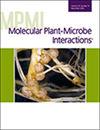Nicholas C Cauldron, Caroline M Press, Alexandra J Weisberg, Marília Horta Jung, Tamara Corcobado, Joan F Webber, Koji Kageyama, Ayaka Hieno, Hayato Masuya, Seiji Uematsu, Bruno Scanu, Clive M Brasier, Thomas Jung, Jeff H Chang, Niklaus J Grünwald
求助PDF
{"title":"栎树猝死病原菌疫霉的种内变异和古代保守效应基因的新近丢失。","authors":"Nicholas C Cauldron, Caroline M Press, Alexandra J Weisberg, Marília Horta Jung, Tamara Corcobado, Joan F Webber, Koji Kageyama, Ayaka Hieno, Hayato Masuya, Seiji Uematsu, Bruno Scanu, Clive M Brasier, Thomas Jung, Jeff H Chang, Niklaus J Grünwald","doi":"10.1094/MPMI-10-24-0131-R","DOIUrl":null,"url":null,"abstract":"<p><p>Members of the <i>Phytophthora</i> genus are responsible for many important diseases in agricultural and natural ecosystems. <i>Phytophthora ramorum</i> causes devastating diseases of oak and tanoak stands in U.S. forests and larch in the United Kingdom. The four evolutionary lineages involved express different virulence phenotypes on plant hosts, and characterization of gene content is foundational to understanding the basis for these differences. Recent discovery of <i>P. ramorum</i> at its candidate center of origin in Asia provides a new opportunity for investigating the evolutionary history of the species. We assembled high-quality genome sequences of six <i>P. ramorum</i> isolates representing three lineages from Asia and three causing epidemics in Western U.S. forests. The six genomes were assembled into 13 putative chromosomes. Analysis of structural variation revealed multiple chromosome fusion and fission events. Analysis of putative virulence genes revealed variations in effector gene composition among the sequenced lineages. We further characterized their evolutionary history and inferred a contraction of crinkler-encoding genes in the subclade of <i>Phytophthora</i> containing <i>P. ramorum</i>. There were losses of multiple families and a near complete loss of paralogs in the largest core crinkler family in the ancestor of <i>P. ramorum</i> and sister species <i>P. lateralis</i>. Secreted glycoside hydrolase enzymes showed a similar degree of variation in abundance among genomes of <i>P. ramorum</i> lineages as that observed among several <i>Phytophthora</i> species. We found plasticity among genomes from multiple lineages in a <i>Phytophthora</i> species and provide insights into the evolutionary history of a class of anciently conserved effector genes. [Formula: see text] Copyright © 2025 The Author(s). This is an open access article distributed under the CC BY 4.0 International license.</p>","PeriodicalId":19009,"journal":{"name":"Molecular Plant-microbe Interactions","volume":" ","pages":"440-453"},"PeriodicalIF":3.4000,"publicationDate":"2025-05-01","publicationTypes":"Journal Article","fieldsOfStudy":null,"isOpenAccess":false,"openAccessPdf":"","citationCount":"0","resultStr":"{\"title\":\"Intraspecific Variation and Recent Loss of Ancient, Conserved Effector Genes in the Sudden Oak Death Pathogen <i>Phytophthora ramorum</i>.\",\"authors\":\"Nicholas C Cauldron, Caroline M Press, Alexandra J Weisberg, Marília Horta Jung, Tamara Corcobado, Joan F Webber, Koji Kageyama, Ayaka Hieno, Hayato Masuya, Seiji Uematsu, Bruno Scanu, Clive M Brasier, Thomas Jung, Jeff H Chang, Niklaus J Grünwald\",\"doi\":\"10.1094/MPMI-10-24-0131-R\",\"DOIUrl\":null,\"url\":null,\"abstract\":\"<p><p>Members of the <i>Phytophthora</i> genus are responsible for many important diseases in agricultural and natural ecosystems. <i>Phytophthora ramorum</i> causes devastating diseases of oak and tanoak stands in U.S. forests and larch in the United Kingdom. The four evolutionary lineages involved express different virulence phenotypes on plant hosts, and characterization of gene content is foundational to understanding the basis for these differences. Recent discovery of <i>P. ramorum</i> at its candidate center of origin in Asia provides a new opportunity for investigating the evolutionary history of the species. We assembled high-quality genome sequences of six <i>P. ramorum</i> isolates representing three lineages from Asia and three causing epidemics in Western U.S. forests. The six genomes were assembled into 13 putative chromosomes. Analysis of structural variation revealed multiple chromosome fusion and fission events. Analysis of putative virulence genes revealed variations in effector gene composition among the sequenced lineages. We further characterized their evolutionary history and inferred a contraction of crinkler-encoding genes in the subclade of <i>Phytophthora</i> containing <i>P. ramorum</i>. There were losses of multiple families and a near complete loss of paralogs in the largest core crinkler family in the ancestor of <i>P. ramorum</i> and sister species <i>P. lateralis</i>. Secreted glycoside hydrolase enzymes showed a similar degree of variation in abundance among genomes of <i>P. ramorum</i> lineages as that observed among several <i>Phytophthora</i> species. We found plasticity among genomes from multiple lineages in a <i>Phytophthora</i> species and provide insights into the evolutionary history of a class of anciently conserved effector genes. [Formula: see text] Copyright © 2025 The Author(s). This is an open access article distributed under the CC BY 4.0 International license.</p>\",\"PeriodicalId\":19009,\"journal\":{\"name\":\"Molecular Plant-microbe Interactions\",\"volume\":\" \",\"pages\":\"440-453\"},\"PeriodicalIF\":3.4000,\"publicationDate\":\"2025-05-01\",\"publicationTypes\":\"Journal Article\",\"fieldsOfStudy\":null,\"isOpenAccess\":false,\"openAccessPdf\":\"\",\"citationCount\":\"0\",\"resultStr\":null,\"platform\":\"Semanticscholar\",\"paperid\":null,\"PeriodicalName\":\"Molecular Plant-microbe Interactions\",\"FirstCategoryId\":\"99\",\"ListUrlMain\":\"https://doi.org/10.1094/MPMI-10-24-0131-R\",\"RegionNum\":3,\"RegionCategory\":\"生物学\",\"ArticlePicture\":[],\"TitleCN\":null,\"AbstractTextCN\":null,\"PMCID\":null,\"EPubDate\":\"2025/6/3 0:00:00\",\"PubModel\":\"Epub\",\"JCR\":\"Q2\",\"JCRName\":\"BIOCHEMISTRY & MOLECULAR BIOLOGY\",\"Score\":null,\"Total\":0}","platform":"Semanticscholar","paperid":null,"PeriodicalName":"Molecular Plant-microbe Interactions","FirstCategoryId":"99","ListUrlMain":"https://doi.org/10.1094/MPMI-10-24-0131-R","RegionNum":3,"RegionCategory":"生物学","ArticlePicture":[],"TitleCN":null,"AbstractTextCN":null,"PMCID":null,"EPubDate":"2025/6/3 0:00:00","PubModel":"Epub","JCR":"Q2","JCRName":"BIOCHEMISTRY & MOLECULAR BIOLOGY","Score":null,"Total":0}
引用次数: 0
引用
批量引用

 求助内容:
求助内容: 应助结果提醒方式:
应助结果提醒方式:


